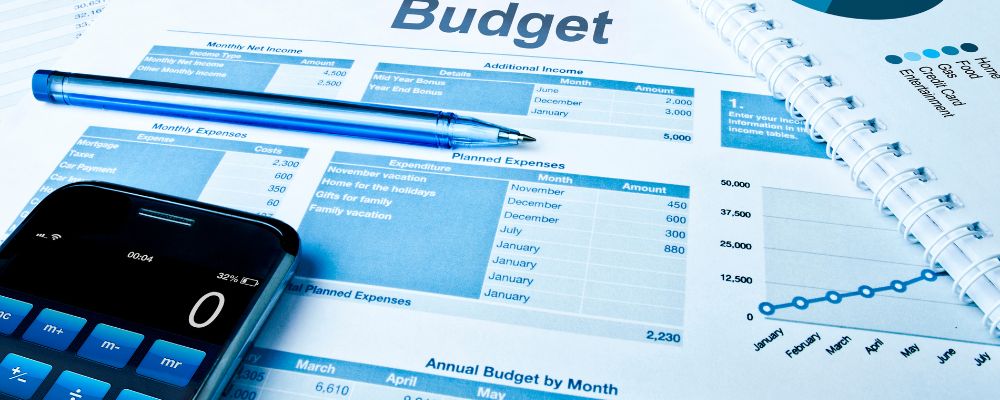Here’s a step-by-step guide to creating a budget and sticking to it:

1. Assess Your Financial Situation
Before creating a budget, it's important to get a clear understanding of your current financial situation. This involves reviewing your income, expenses, and any outstanding debts.
- List Your Income: Start by calculating your total monthly income. Include all sources of income such as your salary, freelance work, investments, or government benefits.
- Track Your Expenses: Make a list of all your monthly expenses. This includes rent/mortgage payments, utilities, groceries, transportation, insurance, and any other recurring costs. Don’t forget discretionary spending, such as dining out, entertainment, and subscriptions.
You can track your expenses manually, using a spreadsheet, or by using budgeting apps that automate the process.
2. Categorize Your Expenses
Next, categorize your expenses into fixed and variable categories.
- Fixed Expenses: These are essential costs that remain the same each month, such as rent, utilities, loan payments, and insurance premiums.
- Variable Expenses: These fluctuate from month to month, such as groceries, dining out, entertainment, and clothing. You have more control over these costs, making them easier to adjust when needed.
3. Set Financial Goals
Establishing clear financial goals gives you a sense of purpose and motivation to stick to your budget. Your goals can be short-term (e.g., saving for a vacation or paying off a credit card) or long-term (e.g., building an emergency fund, buying a house, or planning for retirement).
- SMART Goals: Make sure your goals are Specific, Measurable, Achievable, Relevant, and Time-bound. For example, instead of saying "I want to save money," set a goal like, "I want to save $2,000 in six months for a new laptop."
4. Create a Budget Plan
Now that you have a clear understanding of your financial situation and goals, it’s time to create a budget. Use the following steps to allocate your income:
- Allocate for Essentials: Start by allocating a portion of your income to cover essential expenses (rent, utilities, groceries, and debt payments).
- Set Savings Goals: Next, set aside money for your savings goals. Ideally, aim to save at least 20% of your income, but adjust this based on your financial situation.
- Budget for Variable Expenses: Determine how much you can allocate for non-essential, variable expenses, such as entertainment, dining out, and shopping.
Popular Budgeting Methods:
- 50/30/20 Rule: A common budgeting strategy where you allocate 50% of your income for needs (essentials), 30% for wants (non-essentials), and 20% for savings and debt repayment.
- Zero-Based Budget: In this method, you allocate every dollar of your income toward a specific category (expenses, savings, or debt), leaving you with $0 at the end of the month.
5. Use Budgeting Tools
Several tools can help simplify budgeting and make it easier to track your progress. You can use:
- Budgeting Apps: Apps like Mint, YNAB (You Need a Budget), or PocketGuard help you categorize expenses, track your spending, and monitor your progress toward financial goals.
- Spreadsheets: If you prefer manual tracking, creating a budget in a spreadsheet (like Excel or Google Sheets) allows you to fully customize your categories and calculations.
6. Monitor Your Spending
Consistently monitoring your spending helps you stay on track. Review your budget regularly to see if you're staying within your limits. If you’re overspending in a particular category, adjust your future spending accordingly.
- Track Daily or Weekly: Make it a habit to check your spending daily or weekly to ensure you’re following your plan.
- Cut Unnecessary Expenses: If you notice certain categories, like dining out or entertainment, are causing you to exceed your budget, look for ways to cut back on those expenses.
7. Build an Emergency Fund
An emergency fund is a critical part of any financial plan. It helps you cover unexpected expenses (e.g., car repairs, medical bills, or job loss) without disrupting your budget. Aim to save at least three to six months’ worth of living expenses in an easily accessible account.
- Automate Savings: Set up an automatic transfer from your checking account to your savings account each month to ensure you're consistently contributing to your emergency fund.
8. Be Realistic and Flexible
Your budget should reflect your lifestyle and financial realities. Don’t create an overly restrictive budget that leaves you feeling deprived, as it will be harder to stick to. Instead, be realistic about your needs and habits.
- Adjust as Needed: Life circumstances change, so be prepared to adjust your budget if necessary. For example, if you get a raise, you may want to allocate more toward savings. Conversely, if your income decreases, you may need to cut back on non-essential spending.
9. Stay Motivated
Sticking to a budget requires discipline, but it can also be rewarding. Celebrate your progress, especially when you reach a financial milestone, such as paying off a loan or reaching a savings goal.
- Track Progress: Keep a visual representation of your progress, like a chart or graph, to stay motivated.
- Reward Yourself: Occasionally reward yourself for sticking to your budget by indulging in a small treat or experience that won’t derail your finances.
10. Avoid Common Pitfalls
To ensure success with your budget, be mindful of these common budgeting mistakes:
- Underestimating Expenses: Don’t underestimate your monthly expenses or leave out irregular costs like car maintenance or holiday spending. Incorporate these into your budget as much as possible.
- Using Credit to Cover Shortfalls: Avoid using credit cards to cover spending gaps. If you're consistently overspending, re-evaluate your budget and make necessary adjustments.
- Impulse Purchases: Keep impulse purchases in check by creating a “waiting period” before making unplanned purchases. This gives you time to consider if the expense is truly necessary.
